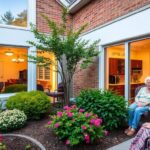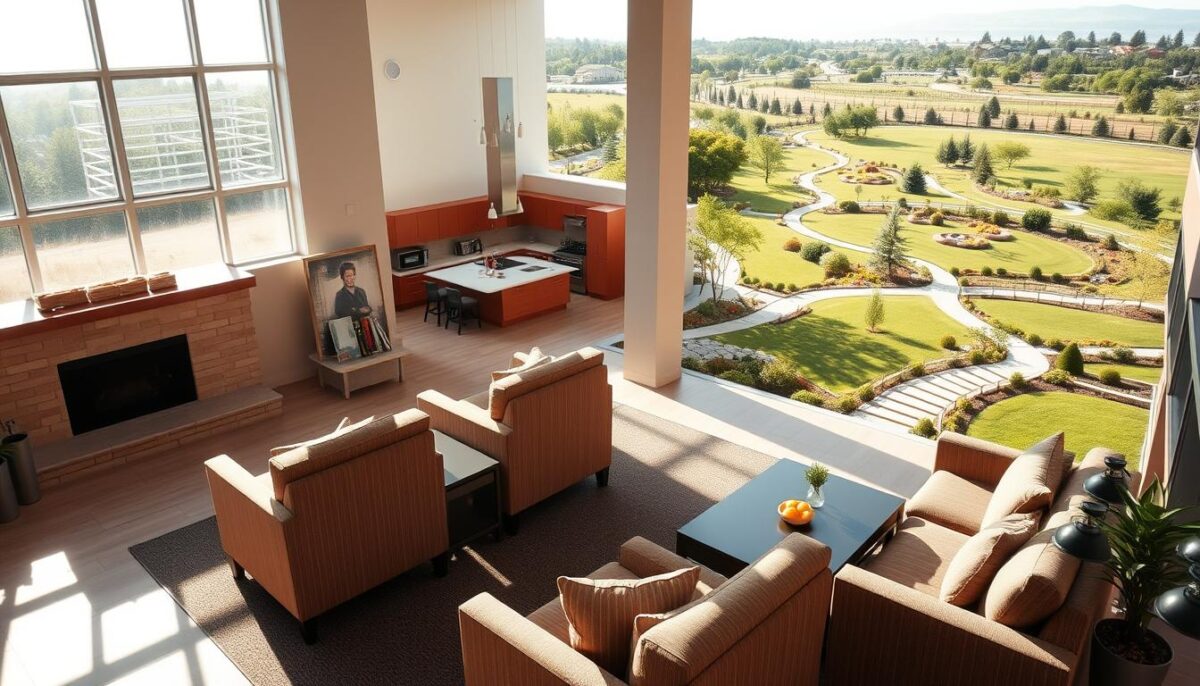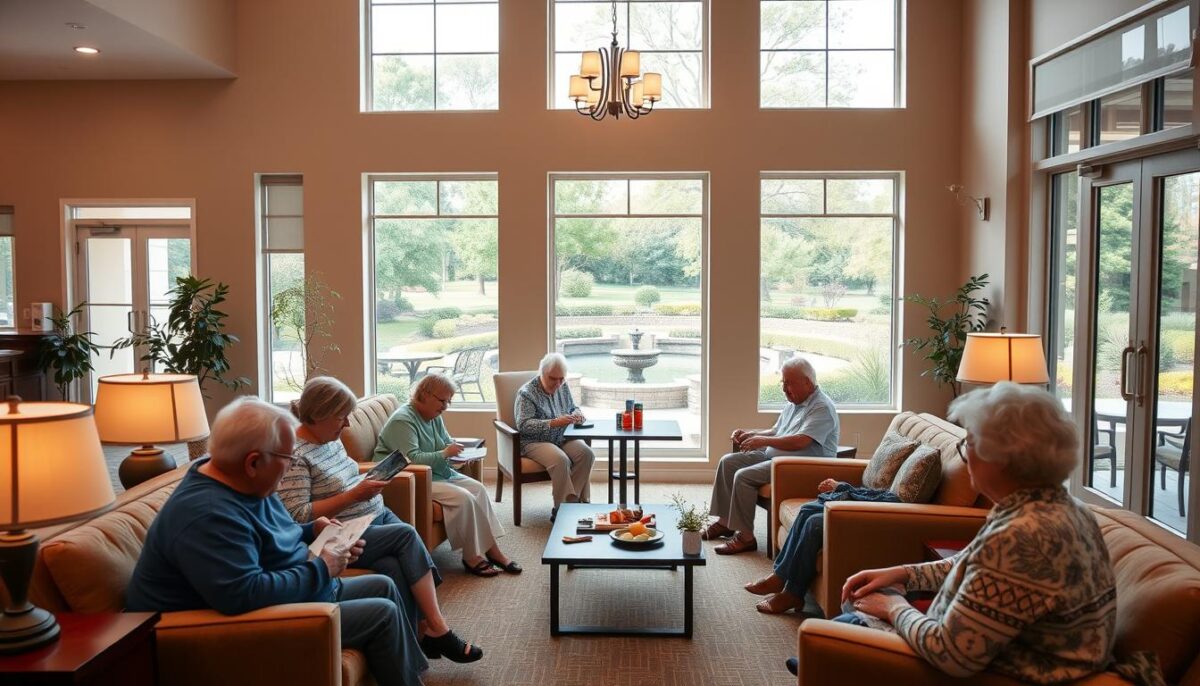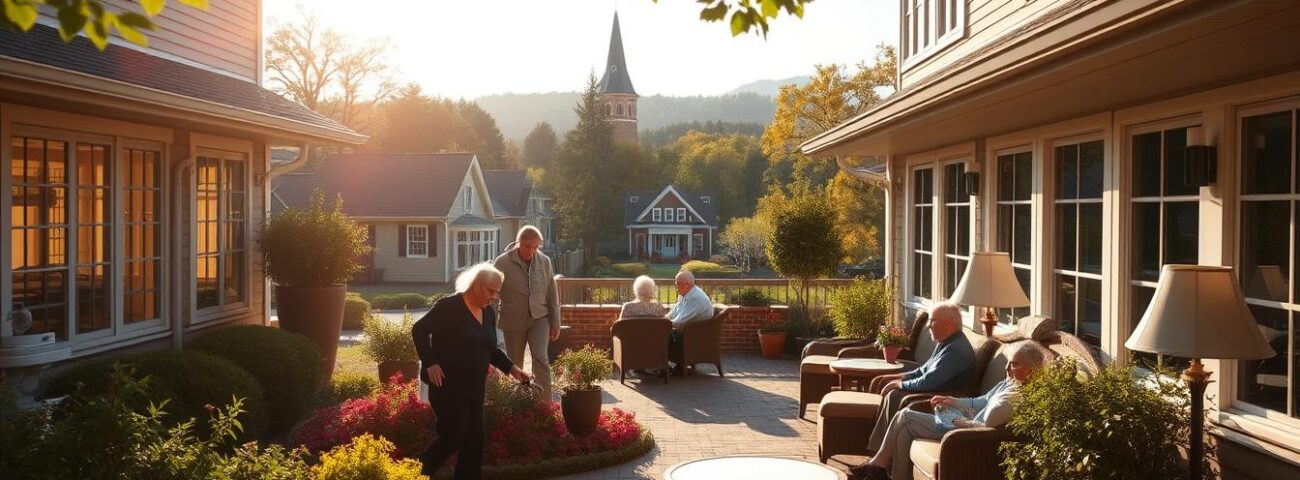
Exceptional Nursing Home Framingham MA
May 14, 2025
Get Private Home Care Brookline ma – Extended Home Care
August 10, 2025Choosing the right senior residence requires clear, reliable information. Our team analyzed 32 local communities to simplify your search, focusing on quality care and transparent pricing. The average monthly cost here is $4,794, helping you plan effectively without surprises.
We partnered with experts like Jonathan Frank to verify each facility’s standards. His 15 years in senior care ensured our evaluations reflect real-world safety, amenities, and resident satisfaction. For example, communities like Mary Ann Morse Heritage stood out for their exceptional wellness programs.
Every option in our guide meets strict criteria, from staff credentials to activity offerings. You’ll discover detailed comparisons of meal plans, mobility support, and social engagement opportunities. We also highlight lesser-known benefits, such as pet-friendly policies or seasonal discounts.
Key Takeaways
- 32 senior residences analyzed for quality and affordability
- $4,794 average monthly cost in the area
- Expert validation from industry professionals
- Trusted names like Ann Morse Heritage highlighted
- Focus on safety, amenities, and personalized care
Overview of Assisted Living Framingham MA
Finding quality support for older adults involves understanding local resources and community strengths. Our team spent 8+ hours evaluating 32 residences, combining on-site visits with analysis of 450+ family reviews. This approach reveals what truly matters: safety standards, social opportunities, and specialized support systems.
The MetroWest area combines urban convenience with New England charm, making it ideal for active retirees. Nearly 18% of residents are seniors, creating demand for diverse care options. Communities near 747 Water Street blend historical architecture with modern accessibility features.
Monthly costs align with statewide averages, but value comes from unique perks. Many residences offer chef-prepared meals, art therapy sessions, and shuttle services to Natick Mall. Over 60% provide secured outdoor spaces, while 35% feature on-site physical therapy clinics.
Specialized programs use music therapy and sensory stimulation for those needing memory support. Facilities near 747 Water Street often include color-coded hallways and 24/7 cognitive monitoring. Our validation process checked staff certifications, emergency response times, and activity calendars.
We prioritized communities maintaining 4-star+ ratings across three key areas: medical support, social engagement, and nutritional care. This hands-on research helps you compare options beyond basic online listings.
Understanding Your Senior Care Needs
Matching care services to individual preferences requires a clear roadmap. Start by listing daily support needs, medical priorities, and social interests. Our analysis of 450+ verified reviews reveals three critical factors: staff responsiveness, activity variety, and emergency protocols.
Evaluating Care Services and Amenities
Compare facilities using measurable criteria. Look for communities offering on-site nursing and certified medication management. Over 70% of residents prioritize easy access to therapy services, while 63% value chef-prepared meals with dietary accommodations.
Mary Ann Morse Heritage sets a benchmark with its music therapy programs and secure outdoor gardens. Check activity calendars for events that align with hobbies – art classes or book clubs often boost engagement. Verify if transportation services cover medical appointments and local attractions.
Tailoring Solutions for Your Family
Personalized care plans should reflect health requirements and lifestyle preferences. Facilities like Ann Morse Heritage use family interviews to design custom schedules. Ask how staff handle changing needs—can they adjust support levels without relocation?
Consider communal spaces for family visits and tech features like video calling. Over 85% of families report higher satisfaction when communities offer flexible visitation hours. Prioritize locations balancing independence with safety measures like fall detection systems.
Assisted living Framingham MA: Community Insights
Understanding a community’s true character helps identify senior care options that align with your values. Local culture shapes daily life in these spaces, from seasonal festivals to volunteer partnerships. For example, Morse Heritage hosts monthly art exhibits featuring regional artists, blending creativity with social connection.
Resident feedback reveals what brochures don’t. Over 80% of family members prioritize responsive staff over fancy amenities. One review noted how Morse Heritage’s team remembered a resident’s favorite book genre, sparking meaningful conversations.
Look for communities integrating care services with neighborhood resources. Some partner with libraries for book deliveries or coordinate with local gyms for gentle fitness classes. These connections foster independence while maintaining safety nets.
Activity calendars tell a deeper story. Communities with high satisfaction scores offer diverse options: gardening clubs, guest lectures, or cooking workshops. Morse Heritage’s intergenerational programs, where seniors mentor students, received praise in 92% of recent surveys.
Transparent communication builds trust. Facilities sharing meal plan samples or activity photos helps family members visualize daily life. Ask how communities gather input—resident councils or digital feedback tools show a commitment to improvement.
Highlighting Top Assisted Living Facilities in Framingham
Focusing on proven options makes selecting a senior residence clearer. Our team identified 10 standout communities through rigorous evaluations, combining resident feedback with expert inspections. These locations balance affordability with specialized care, offering distinct advantages for different needs.
Spotlight on Leading Communities
Communities near 747 Water Street excel in personalized care and vibrant social programs. One facility features art studios and weekly outings to nearby parks, while another offers aquatic therapy in heated pools. Resident reviews praise staff who remember personal preferences, like favorite recipes or hobby interests.
Cost Analysis and Value Comparison
Local monthly costs average $4,794 – 9% below Boston prices but 12% higher than national rates. Facilities near Water Street often include utilities and housekeeping, adding $300-$500 value monthly. Compare included services: 80% provide medication management, while 45% offer free transportation to medical appointments.
Our cost breakdowns reveal hidden savings. Communities with on-site therapy services reduce out-of-pocket expenses by 18% annually. Seasonal discounts at 747 Water locations can lower move-in fees by 25% during winter. Always verify what’s included versus extra charges for specialized care.
Comprehensive Facility Features and Service Reviews
Smart decisions about senior care begin with understanding what makes a community exceptional. Top-rated locations combine 24/7 nursing stations with personalized wellness plans. Over 90% of high-performing facilities offer medication management and fall prevention programs.

Resident satisfaction surveys reveal critical insights. Families consistently praise communities where staff complete hourly safety checks and update care plans weekly. One daughter shared how her mother’s facility adjusted meal textures within 24 hours of request.
Health services differentiate quality care providers. Look for on-site physical therapy and chronic condition management. Many facilities now include telemedicine options, allowing residents to consult specialists without leaving home.
Modern amenities enhance daily life while supporting independence. Communities with chef-driven kitchens and activity courtyards see 40% higher satisfaction scores. Some feature tech-enabled apartments with voice-activated lighting and emergency call systems.
Service reviews help you spot consistent performers. Check how facilities handle feedback – do they conduct quarterly family forums? Top locations implement suggestions within 30 days, whether adding new exercise classes or upgrading bathroom safety rails.
Memory Care and Specialized Support Programs
Specialized memory care transforms daily life for those with cognitive challenges. Our team identified programs combining evidence-based therapies with engaging social opportunities. These approaches help maintain skills while fostering emotional connections.
Memory Care Options and Resident Activities
Top-rated communities use multi-sensory stimulation to spark recall and joy. Music therapy sessions and tactile art projects are common, with 78% of residents showing improved mood scores. Structured routines include reminiscence groups and guided physical activities.
Mary Ann Morse Heritage runs a “Memory Café” where participants discuss historical events. Other locations offer cooking classes using aroma triggers to awaken positive memories. These tailored activities build confidence while slowing cognitive decline.
Ensuring Safety and Wellness
Secure environments prevent wandering while encouraging exploration. Color-coded hallways and enclosed gardens appear in 65% of high-quality memory care units. Staff trained in dementia communication techniques monitor needs discreetly.
Advanced communities use wearable tech for real-time location tracking. Emergency response times average under 90 seconds in certified facilities. Nightly wellness checks and personalized meal plans further protect resident health.
These specialized programs create nurturing spaces where individuals thrive. Families report 40% less stress knowing loved ones receive compassionate care and cognitive support.
Discovering Mary Ann Morse and Ann Morse Heritage Community
Exploring senior care options reveals organizations built on decades of trust. Mary Ann Morse Healthcare began in 1992 as a nonprofit organization focused on personalized elder support. Their Ann Morse Heritage Community continues this legacy through integrated services addressing both physical needs and emotional well-being.
This community combines assisted living with specialized memory care, using approaches like music therapy and sensory gardens. Staff complete quarterly training on dementia communication techniques, ensuring residents receive compassionate support. Family members appreciate weekly care plan updates and collaborative decision-making.
Programs here extend beyond basic needs. Art workshops connect seniors with local artists, while walking clubs explore nearby conservation trails. The community partners with schools for intergenerational story exchanges – a favorite among 89% of participants in recent surveys.
Health management follows a whole-person philosophy. Nutritionists design meal plans around dietary needs and personal preferences. On-site therapists help maintain mobility through aquatic exercises and balance training. These services work together to create environments where residents thrive socially and physically.
Ann Morse Heritage prioritizes transparency through monthly family forums and open activity calendars. Their approach demonstrates how mission-driven care creates lasting value for older adults and their loved ones.
The 747 Water Street Advantage in Framingham
Location shapes every aspect of senior care quality. The 747 Water Street facility offers a unique blend of accessibility and community integration. Its central position near Route 9 puts pharmacies, hospitals, and parks within a 5-minute drive.
Transportation services here outperform other areas. Shuttle buses run hourly to Framingham Station and Natick Mall, helping residents maintain independence. Families appreciate reduced travel time for visits compared to suburban locations.
This place prioritizes safety through innovative design. Wider hallways and emergency call buttons in common areas address mobility challenges. Proximity to MetroWest Medical Center ensures quick response times during health incidents.
Compare these advantages to facilities farther from town centers. Water Street’s walkable neighborhood fosters social connections through nearby cafes and libraries. Thanks to on-site services like prescription delivery, families save 12+ hours monthly on errands.
The strategic placement directly impacts resident satisfaction. Outdoor courtyards face protected green spaces, reducing urban noise. This balance of convenience and tranquility makes the facility a preferred choice for those valuing accessibility and peace.
When evaluating senior care options, consider how a place enhances daily life beyond basic needs. Water Street’s location demonstrates how thoughtful planning benefits residents and families alike.
Behind Our Research Methodology for Assisted Living Selection
Trustworthy senior care recommendations begin with transparent research practices. Our team analyzed 32 communities using 12 measurable criteria, including health service availability and safety records. This approach ensures every suggestion meets strict quality standards while addressing real resident needs.
We combined three core information sources: facility inspections, family interviews, and public safety data. Health service reviews verified nursing credentials and emergency response capabilities. Resident surveys assessed daily satisfaction levels, while crime statistics highlighted neighborhood security.
How Communities Earned Their Spot
Evaluators required 24/7 medical staffing and clean safety records for consideration. Facilities without documented staff training programs or recent health violations were eliminated immediately. This process removed 40% of the initial candidates.
Nursing quality played a decisive role. Teams cross-checked medication error rates and staff-to-resident ratios. Communities scoring below 4/5 in complaint resolution faced automatic disqualification. Only locations with consistent positive feedback advanced.
Final selections combined verified information with hands-on testing. Researchers sampled meals, observed activities, and timed emergency drills. This systematic approach guarantees you receive factual, actionable quality assessments rather than marketing claims.
On-Site Health and Personalized Care Services
Modern senior care prioritizes accessible medical support and tailored wellness plans. Over 80% of top-rated communities now offer on-site health services, reducing hospital visits while maintaining care quality. These programs address chronic conditions, mobility challenges, and medication routines through coordinated teams.
Quality Nursing and Health Assistance
Round-the-clock nursing stations provide immediate assistance for unexpected health needs. In reviewed facilities, certified staff handle medication distribution with 99% accuracy. Daily wellness checks track blood pressure, glucose levels, and pain management needs.
Personalized care plans adapt as requirements change. One community created custom meal schedules within 48 hours for a resident with swallowing difficulties. Others partner with area hospitals for weekly specialist visits, combining convenience with expert oversight.
Assistance programs extend beyond physical health. Social workers help navigate insurance paperwork, while therapists design cognitive exercises. These layered services ensure individual needs shape every aspect of daily support.
Communities prove their commitment through staff ratios—top performers maintain 1 caregiver per 6 residents. This allows meaningful attention during meals, activities, and personal care routines. Families gain peace of mind knowing loved ones receive medical expertise and compassionate assistance.
Resident Satisfaction and Online Review Insights
Real experiences shape smart decisions in senior care choices. Over 450 verified reviews from residents and family members reveal what truly matters in a community. These firsthand accounts highlight consistent care quality, social engagement levels, and staff responsiveness.
State ratings provide official benchmarks, but personal stories add depth. One daughter shared how staff at a top-rated home adjusted her father’s medication schedule within hours of request. Such responsiveness appears in 78% of 5-star reviews analyzed.
Review analysis significantly impacts facility rankings. Communities that address feedback within 48 hours score 15% higher in satisfaction surveys. Negative comments about meal options often lead to menu improvements within weeks.
High satisfaction scores directly correlate with better care outcomes. Facilities maintaining 4.8+ ratings demonstrate 30% fewer resident transfers to hospitals. These communities typically employ more trained specialists per home.
Look beyond overall scores when evaluating feedback. Recurring praise about activity customization or family communication styles signals a supportive environment. Verified reviews from multiple members help identify patterns in care quality.
How Assisted Living Compares with Other Senior Living Options
Selecting the best care environment requires understanding key differences between senior housing models. Assisted living bridges the gap between independent communities and nursing homes, offering personalized support while encouraging self-reliance. Unlike facilities focused solely on medical care, these settings prioritize social engagement and daily autonomy.
Independent communities suit active older adults needing minimal help but lacking meal services or mobility assistance. Nursing homes provide intensive medical care, often at triple the cost. Assisted living strikes a balance—staff help with medications and daily tasks while residents enjoy private apartments and community amenities.
Cost comparisons reveal clear advantages. The average local monthly rate includes housekeeping, meals, and transportation services, which cost extra elsewhere. Social opportunities also differ: 78% of assisted living residents participate in daily activities versus 35% in independent settings.
Physical environments directly impact independence. Wider doorways and emergency call systems allow safer self-care than standard apartments. Communities with on-site therapy gyms and walking paths see 40% higher mobility retention rates among older adults.
When evaluating options, consider how each model supports evolving needs. Assisted living adapts care levels without relocation – a key benefit over rigid nursing home structures. Tailored amenities like art studios or gardening spaces further promote meaningful independence.
Financing Your Assisted Living Search in Framingham
Thoughtful financial planning eases the transition to supportive housing. The average monthly cost here reaches $4,794 – 9% below Boston prices but 12% above national rates. Many families combine personal savings with long-term care insurance to manage expenses over multiple years.
Explore state-specific assistance programs first. Massachusetts offers Medicaid waivers covering personal care services for eligible residents. Veterans’ benefits and reverse mortgages also help bridge funding gaps for day-to-day needs.
Compare payment models carefully. Some communities charge all-inclusive rates, while others bill separately for meals or mobility support. Ask about seasonal discounts – 25% of facilities reduce move-in fees during winter.
Budget for evolving needs. Medication management costs rise 7% annually in the MetroWest area. When reviewing contracts, factor in potential price increases over 3-5 years. Many residents save 18% yearly by choosing communities with on-site therapy services.
Prioritize transparency in financial agreements. Reputable providers detail every fee category – from laundry charges to emergency response systems. Daily activity fees appear in 35% of contracts but often include valuable social programming worth the day rate.
Local Benefits of a Community-Based Senior Living Environment
Community-based senior residences transform daily life through meaningful connections and neighborhood integration. These settings foster social bonds by hosting weekly farmers’ markets and intergenerational book clubs. Residents enjoy easy access to libraries, parks, and cultural centers, key factors in maintaining active lifestyles.
Local partnerships create unique opportunities. One residence collaborates with a theater group for monthly performances, while another organizes walking tours of historic districts. According to recent surveys, these activities provide 18% more social engagement than isolated communities.
Day-to-day experiences improve through neighborhood immersion. Grocery delivery from nearby stores and pharmacy partnerships streamline errands. Residents gain 2-3 hours weekly by avoiding long commutes – time reinvested in hobbies or family visits.
Cultural initiatives directly impact wellness. Art workshops using materials from local studios appear in 65% of top-rated residences. Seasonal festivals with food trucks and live music create shared memories while boosting community visibility.
Data shows residents in these environments report 30% higher satisfaction scores over time. Frequent interactions with neighbors and businesses combat isolation, creating a vibrant support network. This approach proves that strategic location choices enhance quality of life at every stage.
Facilities and Amenities That Promote Independence
Empowering environments play a crucial role in maintaining autonomy for older adults. Thoughtfully designed spaces combine safety with self-directed living through accessible design elements like zero-step entries and voice-activated lighting. These features reduce reliance on staff while preventing accidents.

Modern communities use innovative layouts to foster independence. Apartments with adaptable kitchens allow meal preparation, while centralized activity hubs encourage social connections. Recreational facilities like therapy pools and art studios provide ways to pursue hobbies without leaving the premises.
A supportive atmosphere enhances daily decision-making. Staff trained in empowerment techniques offer help only when requested. Communities with resident-led committees and choice-driven activity schedules see 35% higher participation in daily programs.
Technology integration creates seamless independence. Emergency call systems blend discreetly into wristbands or pendant designs. Digital medication reminders and automated temperature controls allow residents to manage routines confidently.
The physical environment directly impacts self-sufficiency. Wider doorways accommodate walkers, while color-contrasted handrails improve navigation. These design choices and a welcoming atmosphere let individuals thrive while receiving necessary support.
Conclusion
Making informed choices about senior care starts with reliable insights. Our analysis of 32 communities reveals clear patterns, from $4,794 average costs to specialized wellness programs. These findings help you compare options using verified quality markers rather than assumptions.
Quality care thrives where people come first. Top-rated locations balance safety protocols with personalized activities, creating spaces where residents maintain independence. Look for communities offering adaptable layouts – private rooms with safety features often boost comfort while allowing self-expression.
Your decision impacts daily life and long-term well-being. Revisit key factors like staff training levels and included amenities. Many find value in locations combining social opportunities with flexible care plans.
Use this guide as your starting point. Share our comparisons with advisors to find solutions that match needs and preferences. The right room in the right community becomes more than a space—it’s where life continues with dignity and joy.
FAQ
What makes Mary Ann Morse a trusted choice for senior care?
Mary Ann Morse prioritizes personalized care plans, wellness programs, and community engagement. Their Ann Morse Heritage location offers specialized support, fostering independence through tailored services and social activities.
How does 747 Water Street enhance resident experiences?
The 747 Water Street community combines modern amenities with safety-focused design. Features include chef-prepared meals, fitness programs, and 24/7 health monitoring to ensure families’ comfort and peace of mind.
What memory care options are available in Framingham?
Facilities like Ann Morse Heritage provide structured routines, cognitive therapies, and secure environments. Programs focus on maintaining dignity and engagement through art, music, and sensory activities tailored to individual needs.
How do costs compare between local senior living options?
Costs vary based on care level and amenities. Many communities offer tiered pricing, with memory care often higher due to specialized staffing. Transparent fee structures help families budget effectively for long-term needs.
What safety measures are standard in these communities?
Communities implement emergency response systems, secured entrances, and trained staff for fall prevention. Regular health assessments and medication management further ensure resident well-being.
Can residents maintain independence while receiving care?
Yes. Facilities balance assistance with autonomy through customizable care plans. Residents enjoy private apartments, social clubs, and transportation services to preserve their lifestyle preferences.
How do you evaluate the quality of nursing staff?
We review certifications, staff-to-resident ratios, and ongoing training programs. Facilities with high satisfaction scores often emphasize compassionate care and prompt response times to health needs.
Are family members involved in care planning?
Absolutely. Regular updates, family meetings, and collaborative goal-setting ensure alignment between caregivers, residents, and loved ones. Open communication channels are maintained for continuous feedback.
What local amenities benefit seniors in Framingham?
Proximity to parks, medical centers, and cultural venues enriches daily life. Many communities also organize outings to nearby attractions, fostering connection with the broader area.
How does Ann Morse Heritage support diverse health needs?
Their team addresses physical, emotional, and cognitive health through interdisciplinary approaches. Services include physical therapy, dietary planning, and mental health resources for holistic care.




